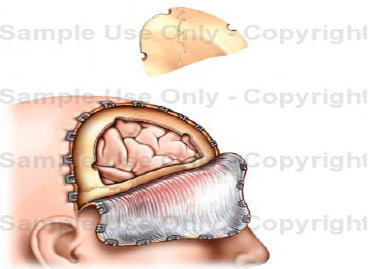What is a craniotomy & repair of anterior cranial fossa floor?
This brain operation is performed to repair the cranial fossa floor and stop the leaking brain fluid.
A cut is usually made on the head through the hairline from ear to ear. A segment of skull bone is removed to allow access to the cranial fossa floor. The area of the leaking brain fluid is identified.
Another cut is made in your upper thigh. This will allow tissue to be taken which is to be used as donor tissue to repair the leaking area of the cranial fossa floor.
Tissue glue may also be used to assist with the repair of the leaking brain fluid. The skull bone is put back and closed with metal plates and screws.
The cuts are closed with stitches or staples.
My Anaesthetic
This procedure will require a General Anaesthetic.
See About your Anaesthetic information sheet for information about the anaesthetic and the risks involved. If you have any concerns, talk these over with your doctor.
If you have not been given an information sheet, please ask for one.
What are the risks of this specific procedure?
There are some risks/complications with this procedure.
Common risks include:
- Infection. This may need antibiotics and further treatment.
- Minor pain, bruising and/or infection from IV cannula site. This may require treatment with antibiotics.
- Bleeding. A return to the operating room for further surgery may be required if bleeding occurs. Bleeding is more common if you have been taking blood thinning drugs such as Warfarin, Asprin, Clopidogrel (Plavix or Iscover) or Dipyridamole (Persantin or Asasantin).
Uncommon risks include:
- A heart attack because of the strain on the heart.
- Stroke or stroke like complications can occur which can cause weakness in the face, arms and legs. This could be temporary or permanent.
- Epilepsy which may require medication. This condition may be temporary or permanent.
- Loss of smell. This may be permanent.
- Memory disturbance or confusion. This could be temporary or permanent.
- Decrease in your normal body salt concentration. This may require admission to intensive care.
- Small areas of the lung may collapse, increasing the risk of chest infection. This may need antibiotics and physiotherapy.
- Increase risk in obese people of wound infection, chest infection, heart and lung complications, and thrombosis.
- Clots in the leg (deep vein thrombosis or DVT) with pain and swelling. Rarely part of this clot may break off and go into the lungs.
Rare risks include:
- Injury to the brain, important nerves or blood vessels. This can lead to stroke like complications which can cause weakness in the face, arms and/or legs.
- Meningitis. This would require further treatment.
- Death is rare due to this procedure.


 Appointments
Appointments